
Portugal - metros, trams and funiculars
Trams of Lisbon
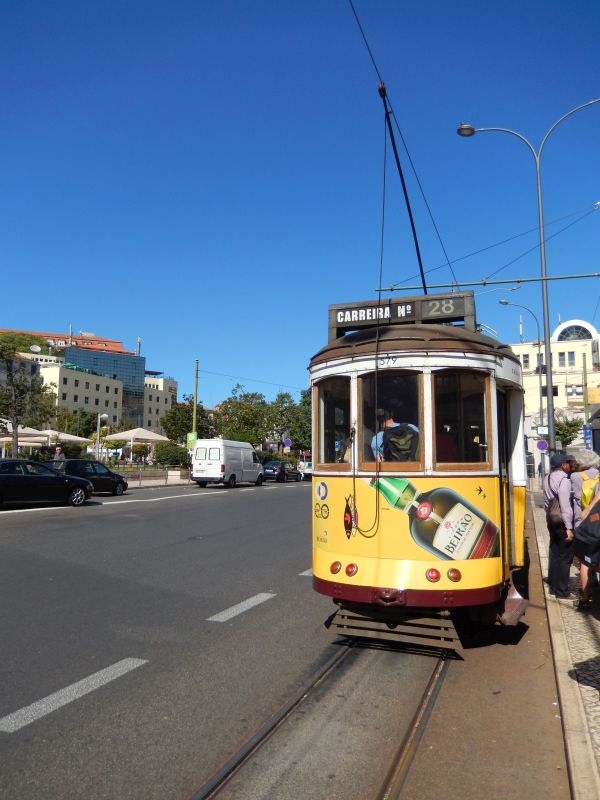
Lisbon tram no.579 on line 28, Praça Martim Moniz - Chiado - Campo de Ourique. This is one of the so called Remodelado (remodelled)
trams (nos 541-585). Lisbon has today 5 tram lines left and a network of 26 km is remaining from a net that once was over 2x larger. Gauge is 900 mm
and the electric system is 600V DC. Lisbon today has only 10 modern trams which only run on line no.15 and all the rest are really old ones intended
mainly for touristic use. Those areas with most tourists and the narrowest roads are run by the very old trams with old style trolley posts up, whereas
at all those places where the aerial catenary wires have already been renewed even the very old trams use modern Einholm style pantographs - something
that looks REALLY odd on 1910-1920s style trams. The old trams have both modern Einholm pantographs as well as old style trolley posts. But here we see
still one of the old style trolley poles up on one of the old trams.
Picture from Lisbon in September 2017 by Ilpo Ruissalo.
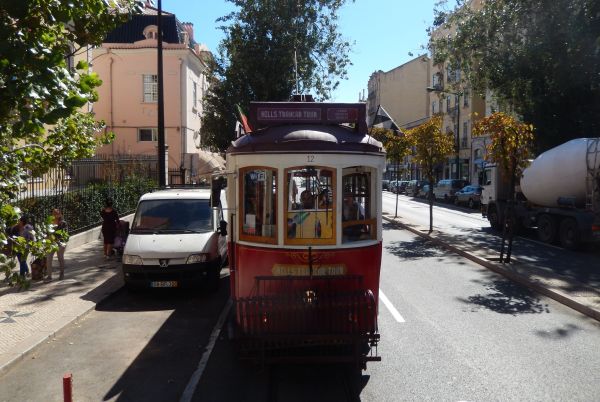
A couple of the "remodelled" old Lisbon trams are painted red and are used as expensive tourist trams running hop on - hop off services.
Here is the tram no. 12 of one of the tourist operators, Hills Tramcars.
Picture from Lisbon in September 2017 by Ilpo Ruissalo.
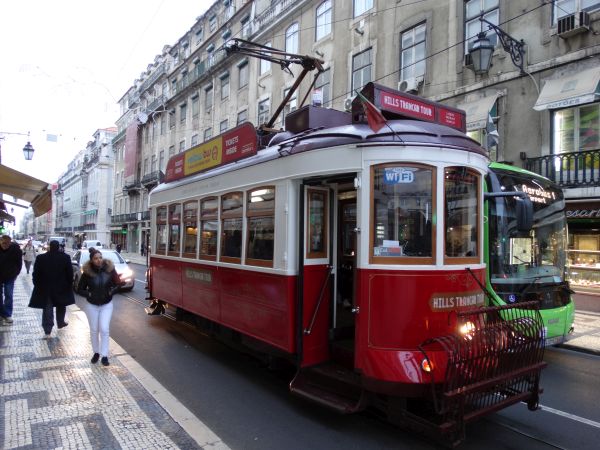
Hills tramcar tours tram no.6 has just arrived at the Praça da Figueira, which is its end station. Here it has used the modern Einholm pantograph
while approaching the Praça da Figueira. Picture by Ilkka Siissalo 13.12.2017.
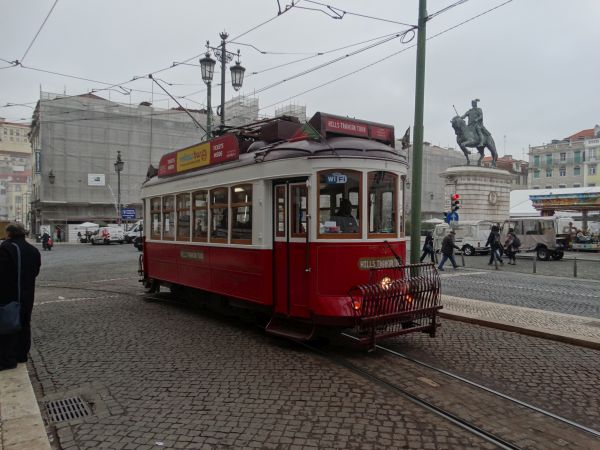
Here the same tram is just around the corner at Praça da Figueira and now it is ready to pick up new tourists. The modern Einholm pantograph is down
and the old fashoned trolley pole is up again. Picture by Ilkka Siissalo 13.12.2017.
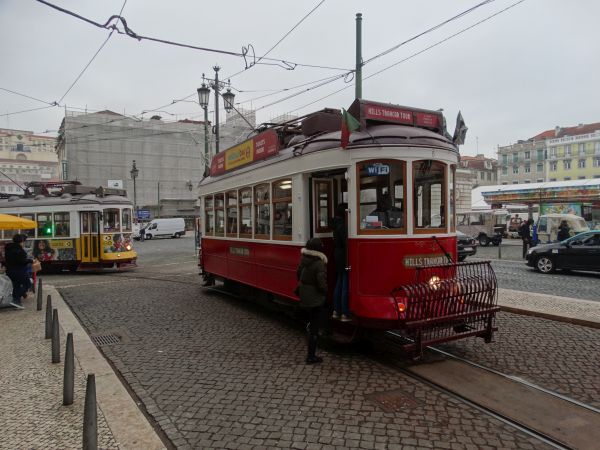
...and now the first Russian tourist is already trying to ask for the price of a sightseeing round. Picture at Praça da Figueira in Lisbon by Ilkka
Siissalo 13.12.2017.
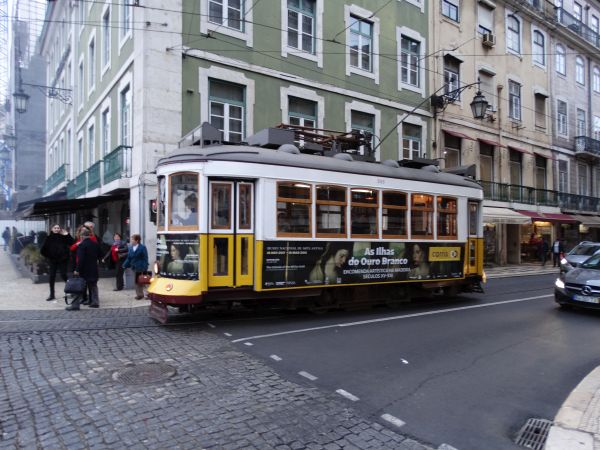
One of the old remodelled trams, no. 555 has just arrived at the Praça da Figueira on line no.12 and is soon ready to board passengers on its way to M.Moniz.
Picture at the Praça da Figueira 13.12.2017 by Ilkka Siissalo.
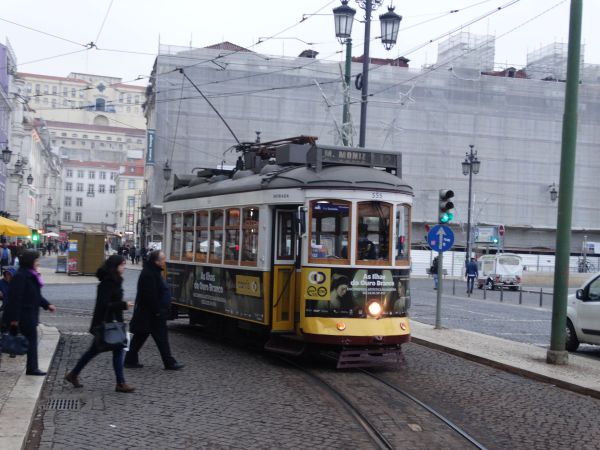
The same old tram no.555 is now ready to board passengers on line 12. Note that it needs to use the old fashioned trolley pole from here on. There is no space
for the modern pantograph to be used.
Picture at the Praça da Figueira 13.12.2017 by Ilkka Siissalo.
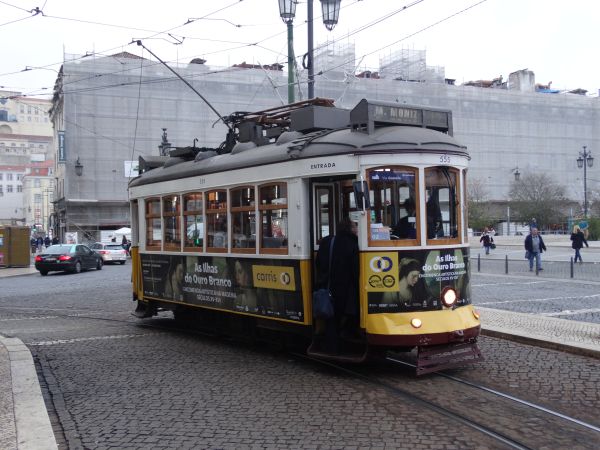
Yet another picture of the same old tram no.555. The old fashioned trolley pole is up and the modern pantograph is down.
Picture at the Praça da Figueira 13.12.2017 by Ilkka Siissalo.
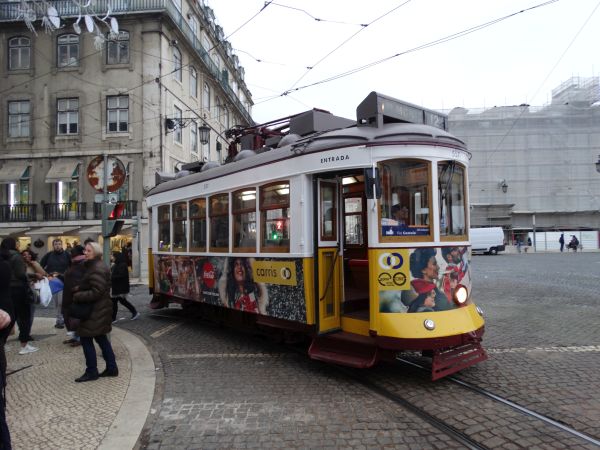
Next tram on line no.12 was the no.557, a very similar one to the 555 shown above.
Picture at the Praça da Figueira 13.12.2017 by Ilkka Siissalo.
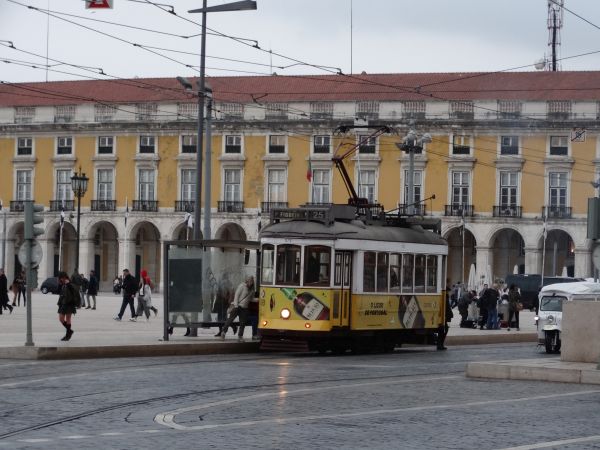
A similar tram no. 572 at the Praça Muniçipio by the shore. Note the use of the modern Einholm pantograph.
Picture 13.12.2017 by Ilkka Siissalo.
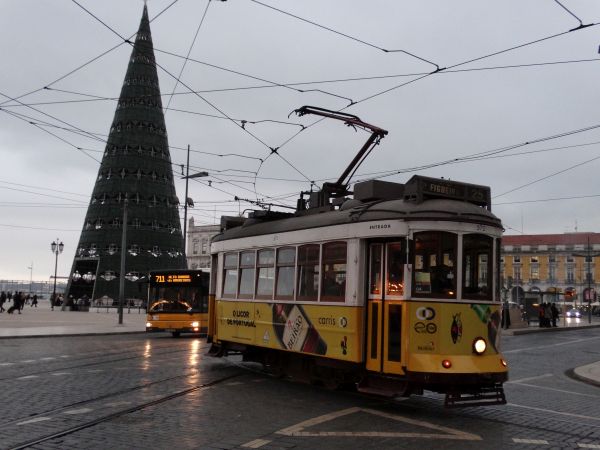
The same tram 572 turning from Praça Muniçipio on to the Rua Prata. The ugly cone like structure in the background is some kind of a "Christmas tree"
made of metal, plastic and led lights.
Picture 13.12.2017 by Ilkka Siissalo.
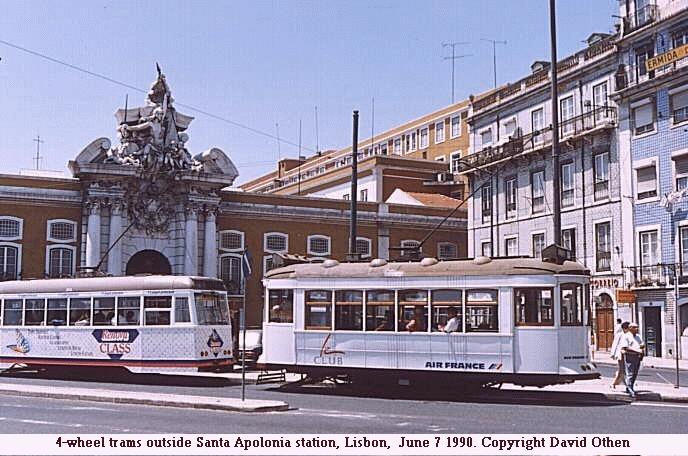
Old two axle trams outside Santa Apolonia station, Lisbon, Portugal, 7 June
1990. Photo by Pat & David Othen. The last trailer wagons were taken out of service in 2011.
Uploaded Nov 22, 1995.
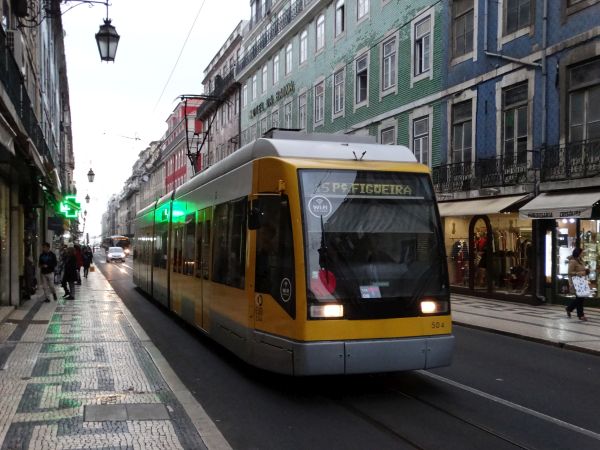
The Lisbon urban rail traffic company Carris (Companhia Carris de Ferro de Lisboa) has in addition to the very old trams also some modern ones
built by Siemens and CAF of Spain.These are three section trams which entered into service in 1995. They are only used on the coastal route no.15
to Algés from Praça da Figueira. Carris has ten of them.
Picture of tram no.504 on Rua Prata 13.12.2017 by Ilkka Siissalo.
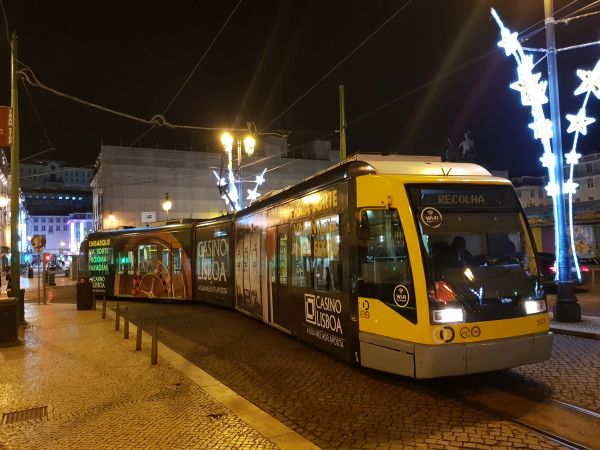
Another one of the modern Siemens/CAF trams, the Carris tram no.507 at Praça da Figueira late in the evening of 12.12.2017.
This one was covered by ugly advertisements. Picture by Ilkka Siissalo.
Metro of Lisbon
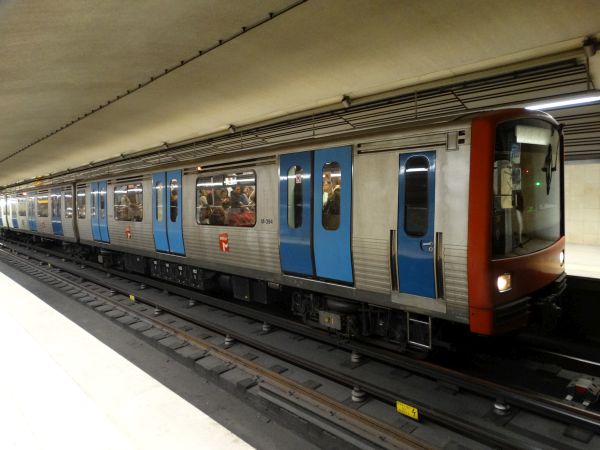
A typical metro train of Lisbon, the M-394 unit at Entre dos Campos station 13.12.2017. Picture by Ilkka Siissalo.
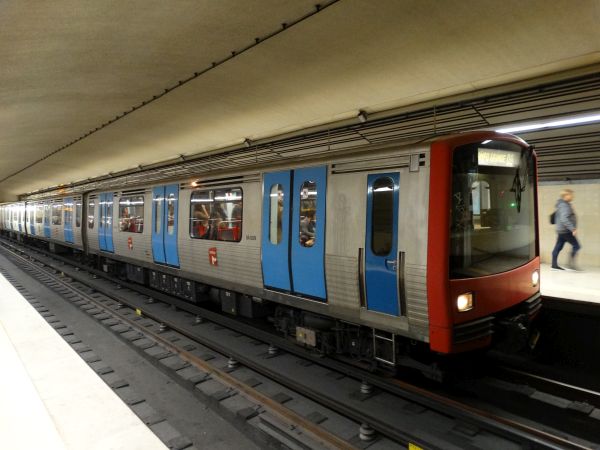
Another Lisbon metro train, the M-509 unit at Entre dos Campos station 13.12.2017. Picture by Ilkka Siissalo.
Funiculars of Lisbon
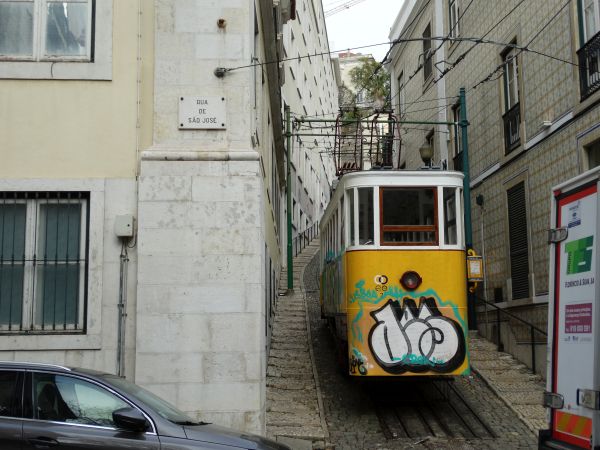
Lisbon is a city which has been built on seven hills and some of them are really steep. There are several old funicular trains and at least
one very old lift which help the pedestrians to climb the mountains. This one is the ascensor Lavra (lift of Lavra) funicular, which essentially
is like a 1910-1920 tram, but built like a funicular with a metal wire hidden under the street. It operates four times per hour in both directions
from the city centre at Rua Câmara Pestana to the hill top at Lg. Anunciada. Unfortunately the nice old tramlike funicular is nowadays spoiled by
ugly graffity sprayings. Picture at Rua Câmara Pestana 13.12.2017 by Ilkka Siissalo.
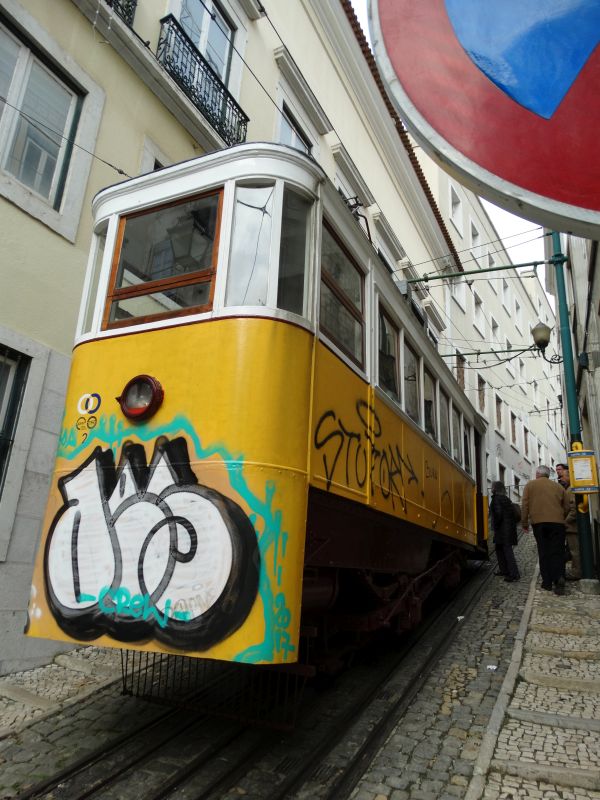
The steets of Lisbon are really steep at some places. Picture of the Ascensor Lavra at Rua Câmara Pestana 13.12.2017 by Ilkka Siissalo.
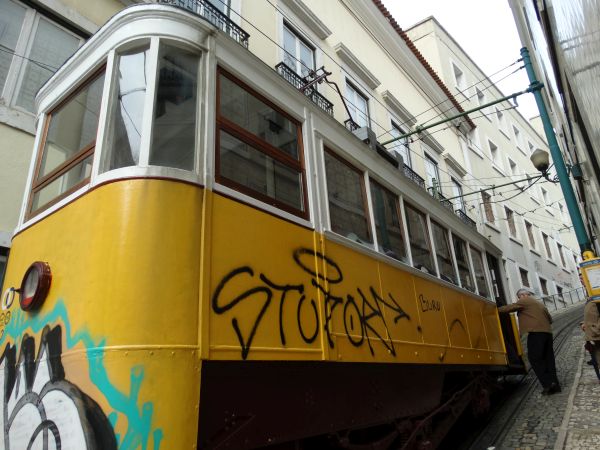
An old gentleman climbing in the old Ascensor Lavra funicular. Picture at Rua Câmara Pestana 13.12.2017 by Ilkka Siissalo.
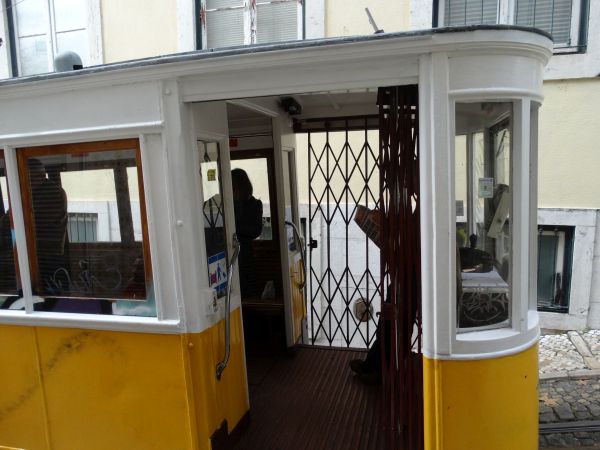
The old ascensor Lavra funicular has no doors, just iron railings. Picture at Rua Câmara Pestana 13.12.2017 by Ilkka Siissalo.
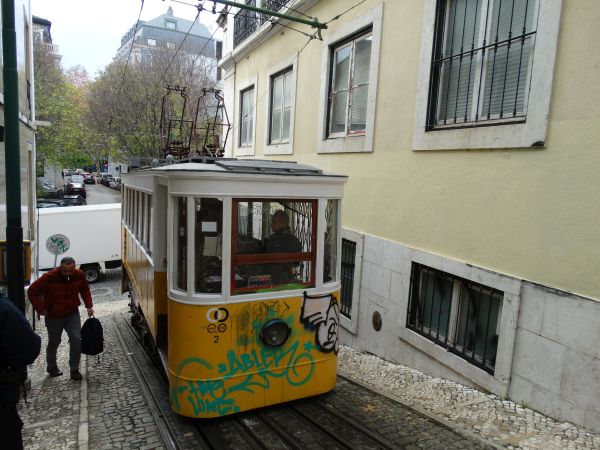
One more passenger climbs to the Ascensor Lavra. Note that the two wagons have three phase current systems with two catenary wires each and metal rolling
rolls taking contact with the catenary wires instead of the more normal pantographs. Both wagons at both ends of the funicular wire also have their own
rails and their own rail-like openings at the center of the rails in the asphalt where the metal wire is hidden under the street, making the street
railings look quite odd. Picture at Rua Câmara Pestana 13.12.2017 by Ilkka Siissalo.
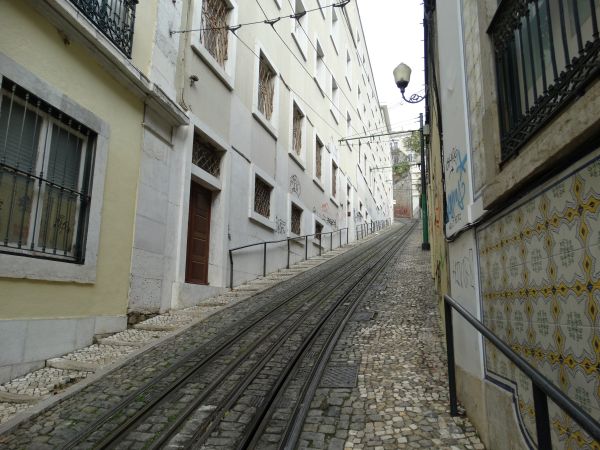
The very peculiar looking rail system of the ascensor Lavra. From left, the left rail of the left hand side wagon of the funicular, then the opening
hiding the metal wire that pulls the funicular wagons for the left hand side wagon, then the right hand side rail of the left hand side wagon, then
the left side rail of the right hand side wagon, the other opening hiding the metal wire that pulls the right hand side wagon and finally the right
hand side wagon's right side rail. Picture at Rua Câmara Pestana 13.12.2017 by Ilkka Siissalo.
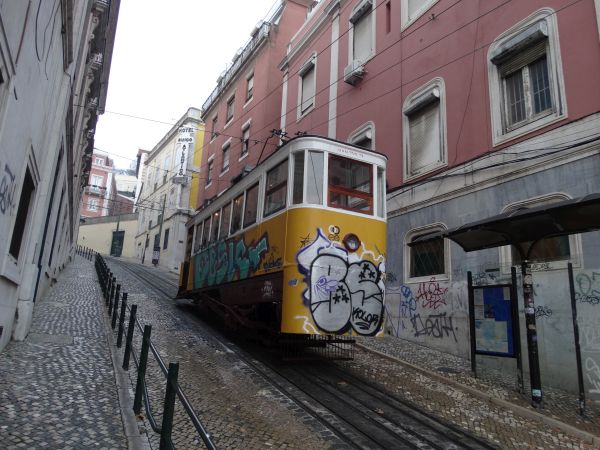
The Ascensor da Glória funicular in Lisbon is very similar to the ascensor Lavra one shown above, and also this one is today unfortunately in a very
disgusting way smeared with graffiti and its windows scraped full of ugly marks. The Ascensor da Glória (lift of Glória) takes people from the square
Praça dos Restauradores (square of restaurant owners) to S Pedro de Alcântara at the top of the hill. Picture at the Praça dos Restauradores
13.12.2017 by Ilkka Siissalo.
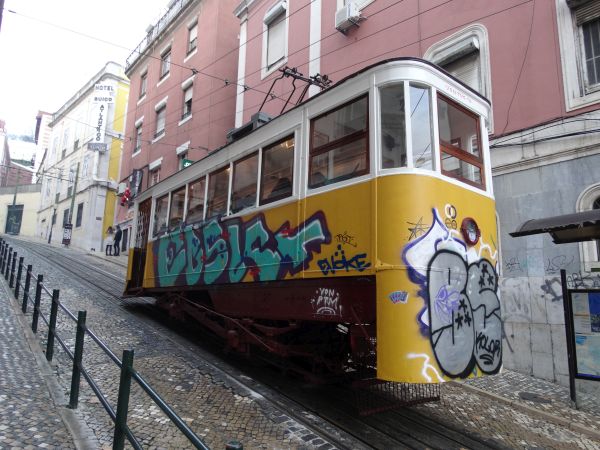
A closer look at the Ascensor da Glória funicular in Lisbon. It looks like a 1910-1920s tram, but it is cable driven and has a three phase current system onboard.
The graffiti and other smear is really awful. Picture at the Praça dos Restauradores 13.12.2017 by Ilkka Siissalo.
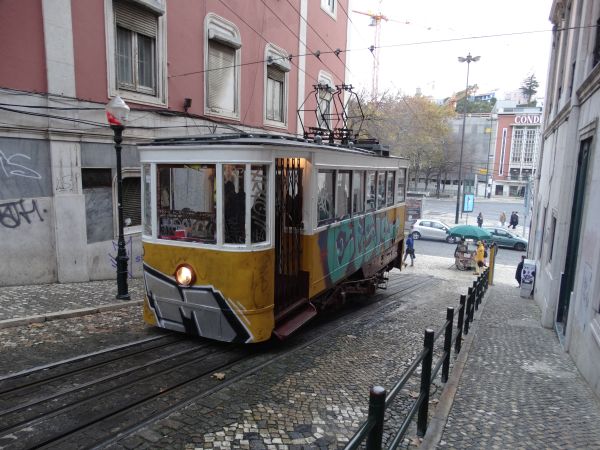
The Ascensor da Glória funicular from the uphill side.
The Glória funicular opened to the public on October 24, 1885, connecting the Restaudores square to the Bairro Alto
or Säo Pedro de Alcântara Belvedere and having a stop at Calçada da Glória¨. Originally it was a narrow gauge train with a rack rail and a metal wire pulling
the train, with a counterballast consisting of running water from the hillside. Later it was a steam engines powered three rail railroad. In 1915 it was converted
to an electric funicular. In 2002 it was declared a national monument - something which hasn't stopped vandals from spraying the cars with ugly graffiti and
spoiling the windows with scrapings.
Picture at the Praça dos Restauradores 13.12.2017 by Ilkka Siissalo.
Trams of Porto
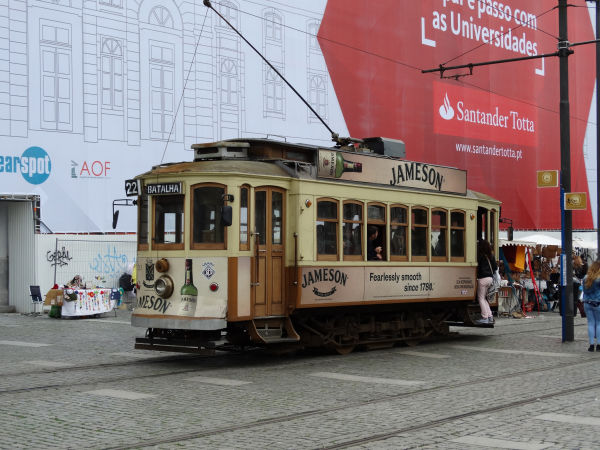
The city transport authority STCP, Sociedade de Transportes Colectivos do Porto operates for the fun of tourists tram traffic on
three lines using very old trams. On the day
these pictures were taken, there was one old tram on each of the 3 lines. Most of the passengers were tourists, but especially on
the line no.1 which runs from the old city center along the river Douro down to Massarelos also normal residents used the tram
to get home from work. Two of the old trams were totally covered by advertisement tapings, but the one on line 1 looked like they used to.
All three lines operated with 30 minutes intervals. The lines are normal gauge 1435 mm and the electric system is 600 V DC overhead.
This tram is on the line 22, a circular line which connects Carmo and Praça da Batalha (Battalion square). Picture in front of the
rectorate of University of Porto 11.3.2017 by Ilkka Siissalo.
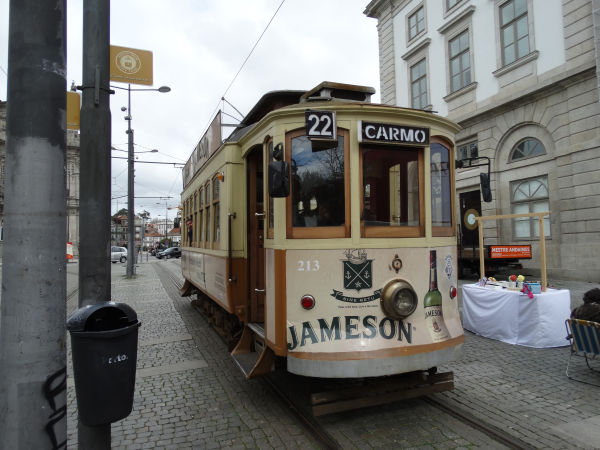
The same tram no. 213 as in the picture above. Picture in front of the
rectorate of University of Porto 11.3.2017 by Ilkka Siissalo.
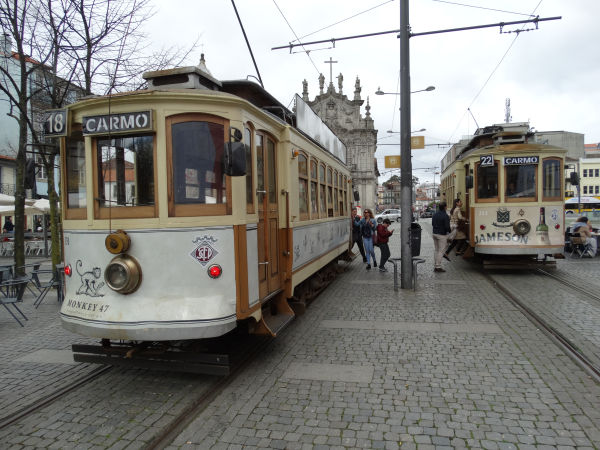
Twice per hour the trams on the touristic tram lines 18 and 22 meet in front of te rectorate of the university of Porto and tourists
can change from one wagon to another. Picture in front of the
rectorate of University of Porto 11.3.2017 by Ilkka Siissalo.
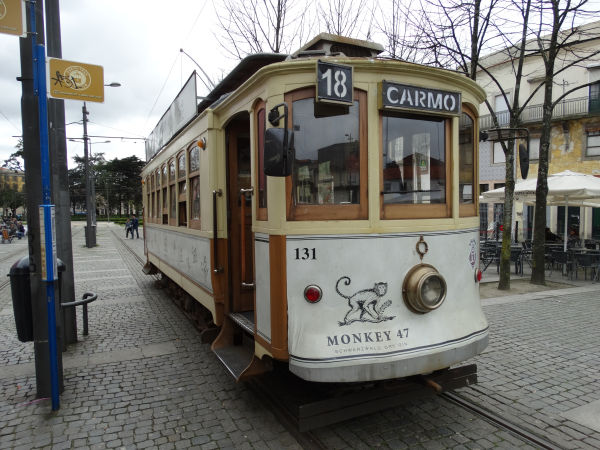
All three wagons in use are probably from the 1910s, although this could not be confirmed anywhere. They had been restored 2007-08
right before touristic traffic on the remaining three lines was restarted in 2008. Picture of the tram no. 131 on line 18 Massarelos-Carmo
in front of the rectorate of University of Porto 11.3.2017 by Ilkka Siissalo.
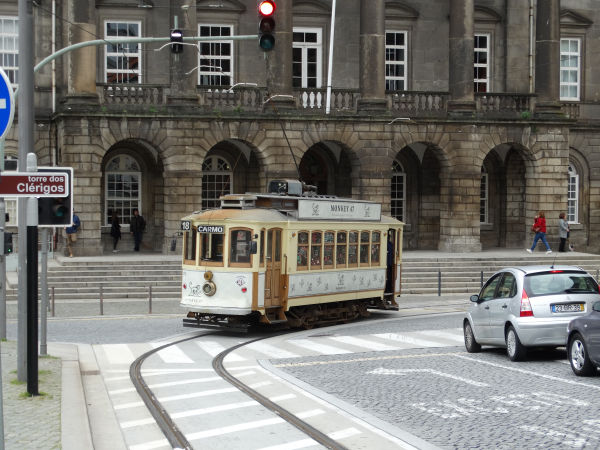
The same wagon no. 131 as above, here en route in front of the museum of Porto's central hospital. Picture 11.3.2017 by Ilkka Siissalo.
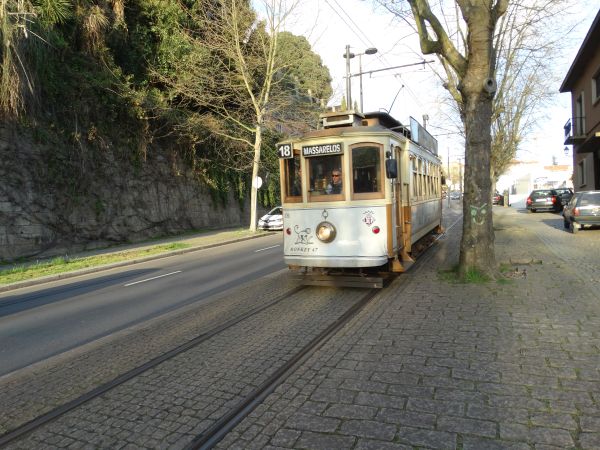
The same wagon no. 131 as above, driving down the steep hill of Rua da Restauracão towards the Douro river.
Most of the tram lines in Porto are single track only, with just some short streches by tram stops where two wagons can
pass each other. Picture 11.3.2017 by Ilkka Siissalo.
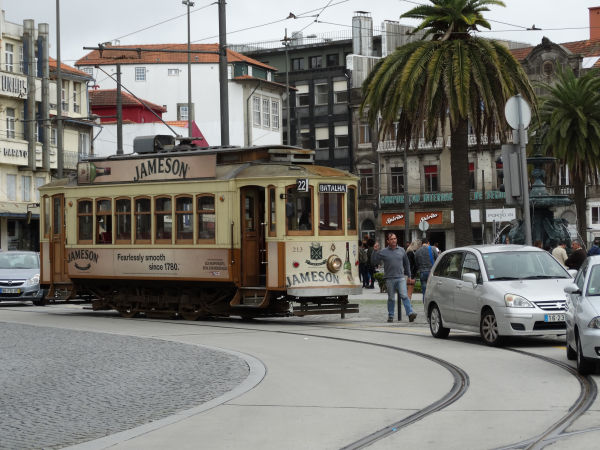
"Madre mio !" These idiots have blocked the switch by parking cars here !! Picture in front of the Igreja do Carmo 11.3.2017 by
Ilkka Siissalo.
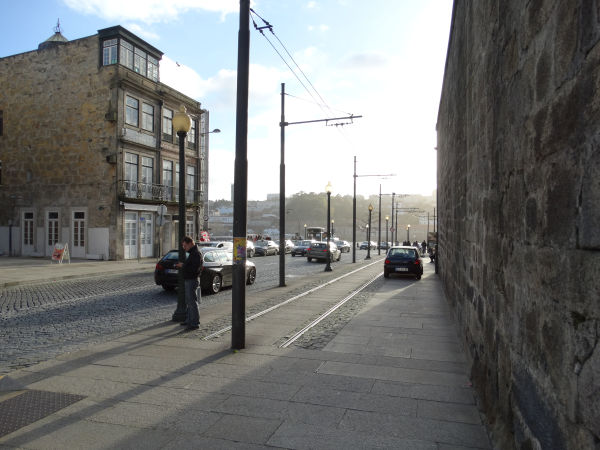
Full stop. The Porto tramline no. 1 which follows river Douro ends RIGHT here :-) Picture 11.3.2017 by
Ilkka Siissalo.
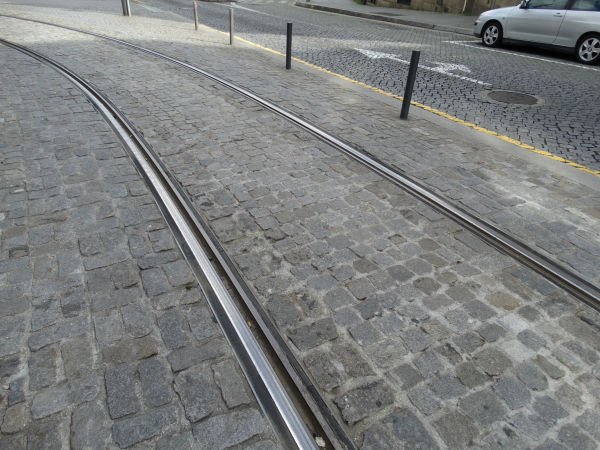
In the old town of Porto museum trams run on very special rails designed to lessen screeching noises by old trams.
The rail is kind of "floating" on top of a rubber insulation layer inside a bigger U-formed rail. It's quite effective. Otherwise old
two axle wagons, the structures of which are naturally quite stiff, would cause a lot of noise in tight bends. Picture 11.3.2017 by
Ilkka Siissalo.
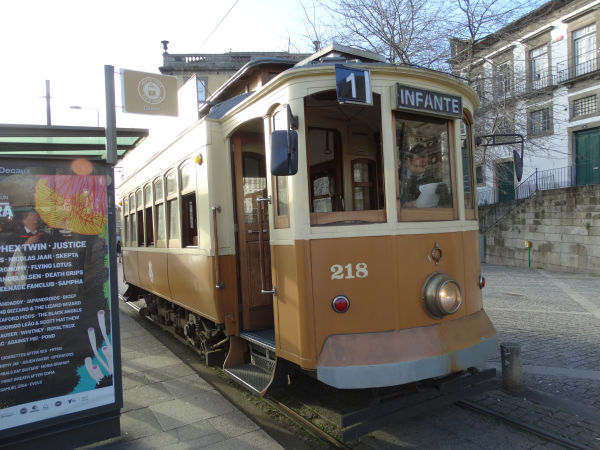
STCP's tram no 218 is one of the last ones not yet spoiled by ugly ad tapings. It has been restored in 2008 to working condition.
Here it has just arrived from line 1 to the last stop called Infante, just downhill from Porto old town towards the river Douro.
Picture 11.3.2017 by Ilkka Siissalo.
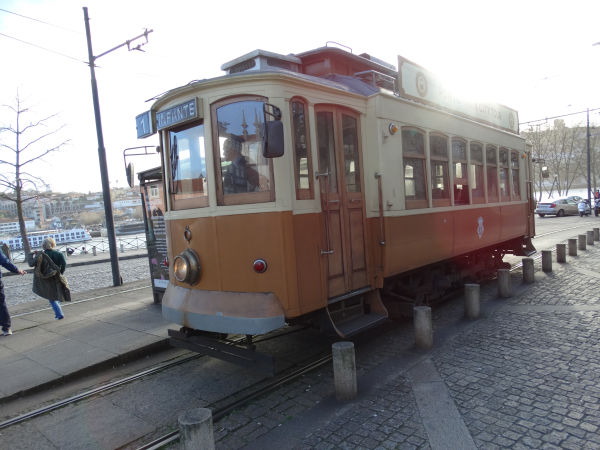
The last tourists have stepped out and now tram 218 is ready to move forward. Then the driver will switch to the other end of the tram.
Picture 11.3.2017 by Ilkka Siissalo.
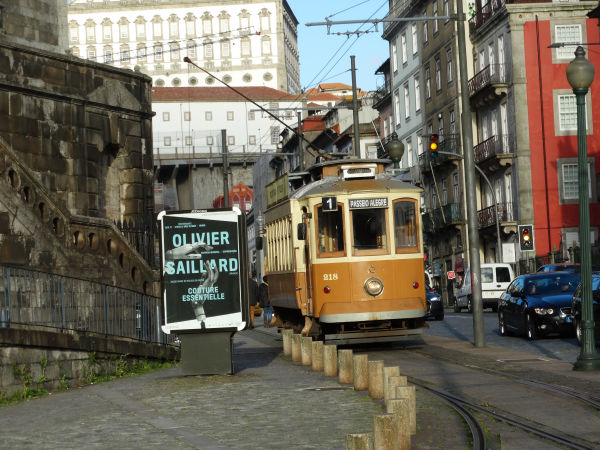
This type of old trams like the STCP no. 218 did not yet have modern pantographs, but only trolleybus style poles. To start driving in the
opposite direction, the driver has to detach a rope from its hanger at the end of the tram and then with the help of the rope turn the long
pole around 180 degrees until it again touches the overhead electric wire at what will now be the back of the tram.
Picture at the tram stop Infante 11.3.2017 by Ilkka Siissalo.
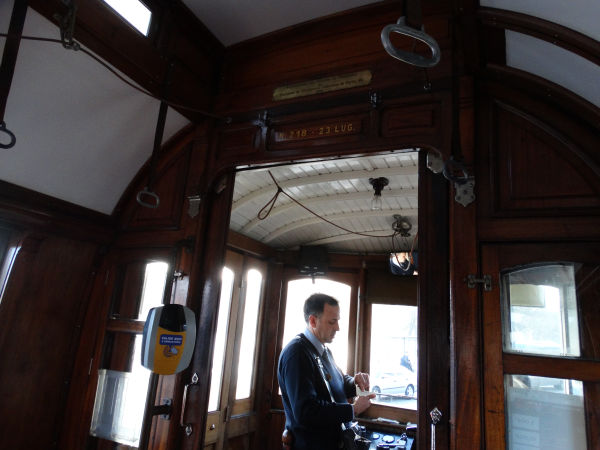
Driver selling tickets to tourists. Locals, who have modern chipcards can pay by showing their card to the modern reader. Tourists pay
3 euros and get an old style cardboard ticket.
Picture at the tram stop Infante 11.3.2017 by Ilkka Siissalo.
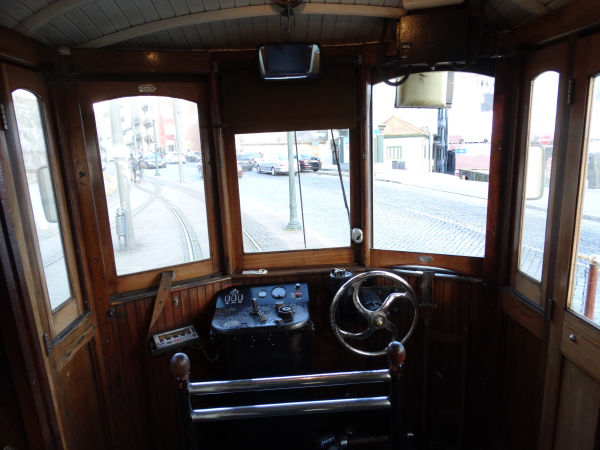
The driver's desk at what is now the back end of tram 218. The tram is from the 1910s, but this desk must be considerably newer.
Notice that there is no driver's seat, just a rest to lean against. The driver has to remain standing while driving.
Picture at the tram stop Infante 11.3.2017 by Ilkka Siissalo.
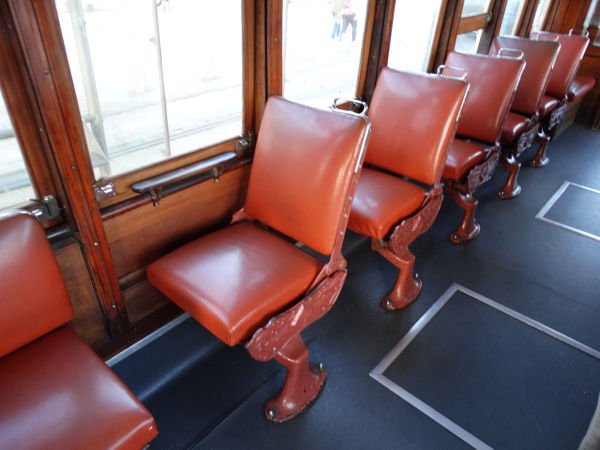
Pure 1910s style chairs, but the carpet and maintenance doors of the floor are clearly from the time the tram was refurbished in 2008.
Picture at the tram stop Infante 11.3.2017 by Ilkka Siissalo.
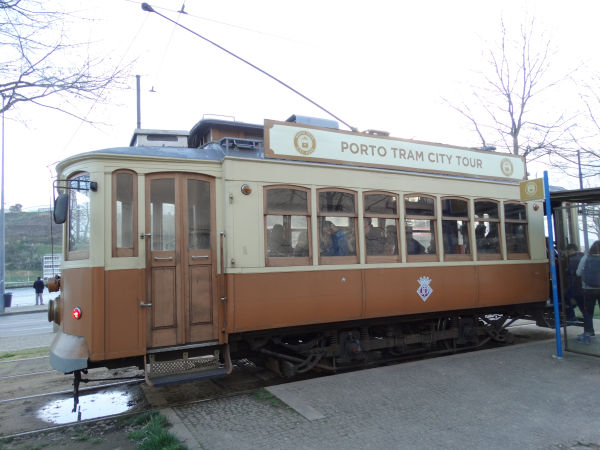
More tourists are cramming in into the small tram.
Picture at the tram stop Cais das Pedras on Porto line 1. 11.3.2017 by Ilkka Siissalo.
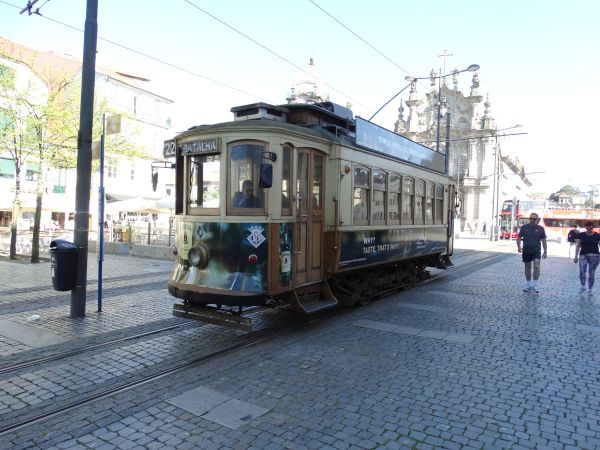
One of the old Porto trams stopping here at Carmo, quite next to the rectorate of Porto University. Several old trams had just received
new whisky advertisement tapings like this one.
Picture from Carmo, Porto 26.4.2018 by Ilkka Siissalo.
Metro of Porto
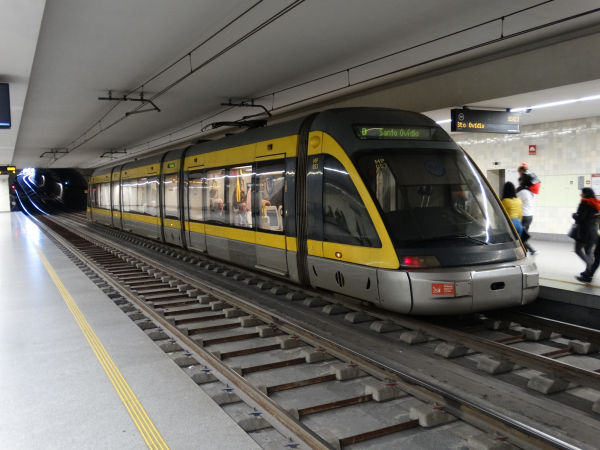
Metro of Porto is a modern light rail system. Under the city center it runs in a typical metro fashion, but not with a third rack
rail but electricity from a catenary wire above. Part of the current metro line used to be earlier a narrow gauge train line.
The metro network leads fairly far away from the city center, even all the way to the airport. Most of the trains are like this one,
modern low floor machines built by Bombardier. The metro system has six lines with a total length of 67 km. It was opened in 2002.
Tracks are normal gauge 1435 mm and the electric system is a tram-like 750V DC overhead. These trains are of the Bombardier type Flexity
Outlook, also known as Eurotram. Picture at São Bento metro station 11.3.2017 by Ilkka Siissalo.
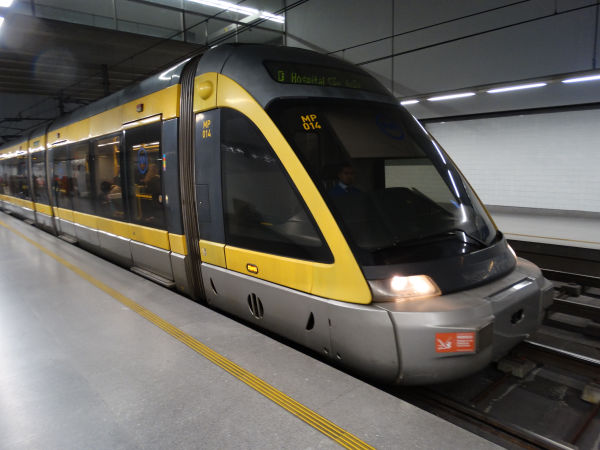
A closer look at the Bombardier Flexity Outlook metro tram.
Picture at Porto São Bento metro station 11.3.2017 by Ilkka Siissalo.
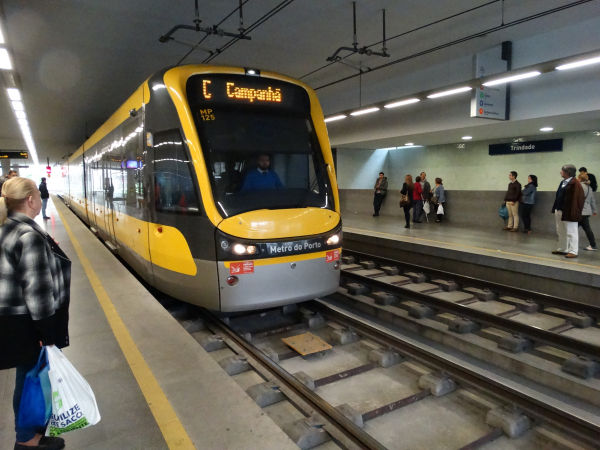
On two of the six Porto metro lines B and C tram-trains of the Bombardier Flexity Swift are used. They are more tram-like
typical light rail vehicles. Picture at Trindade metro station 11.3.2017 by Ilkka Siissalo.
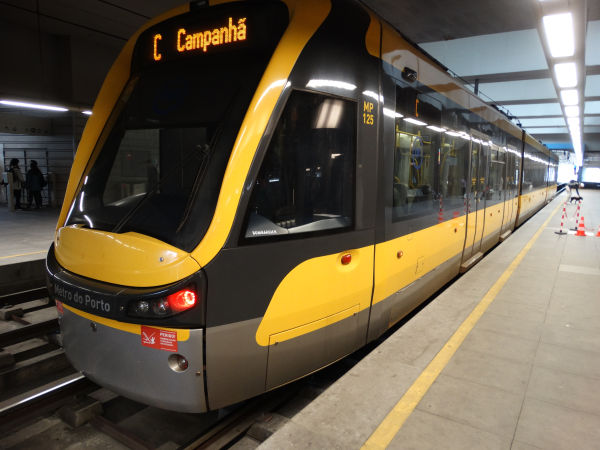
Another view of the same Bombardier Flexity Swift no 125 at Campanhã metro station. Picture 11.3.2017 by Ilkka Siissalo.
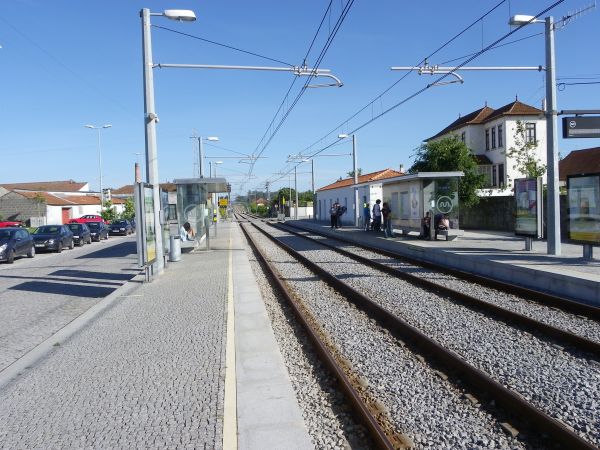
The Metro do Porto system extends from the city northwards a loooooong way outside Porto. This used to be a narrow gauge
railroad previously. This is the metro stop of Mindelo. Picture 23.6.2012 by Ilkka Siissalo.
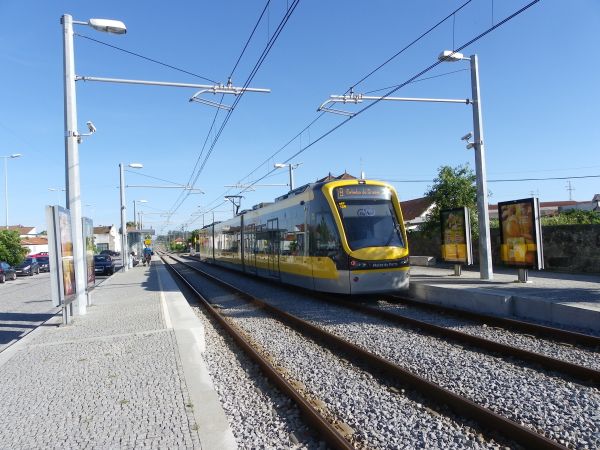
A Flexity Swift on Metro do Porto line B stopping at Mindelo 23.6.2012. Picture by Ilkka Siissalo.
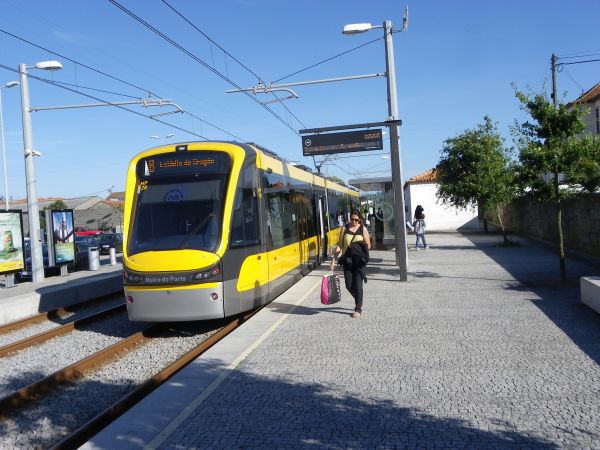
Another view of the same Flexity Swift on Metro do Porto line B stopping at Mindelo 23.6.2012. Picture by Ilkka Siissalo.
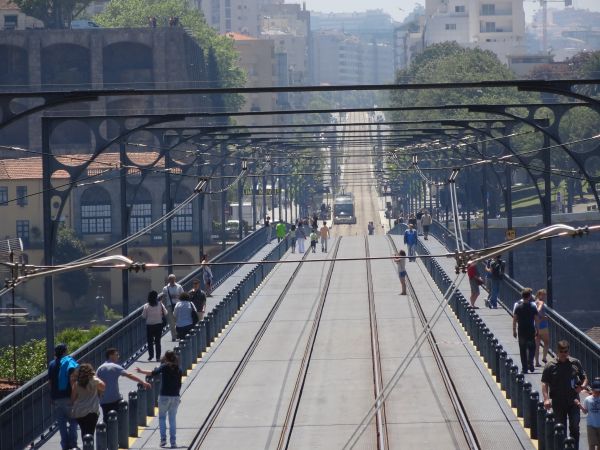
Tracks of Metro do Porto crossing the Douro river at the old town of Porto. The other side of the bridge is no more
Porto, but a part of the city of Gaia. Picture 23.6.2012 by Ilkka Siissalo.
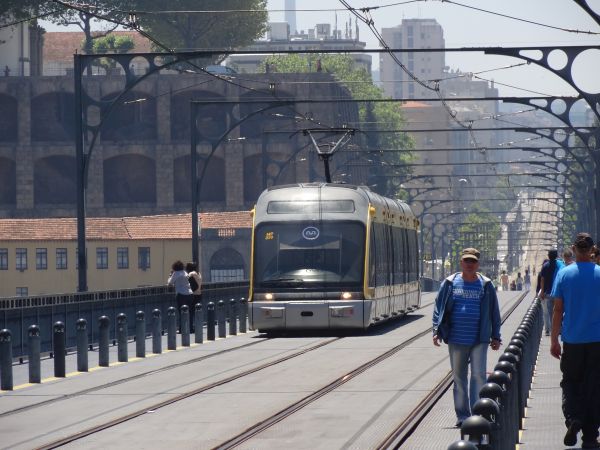
Metro do Porto Flexity Outlook no. 020 crossing the river Douro. Picture 23.6.2012 by Ilkka Siissalo.
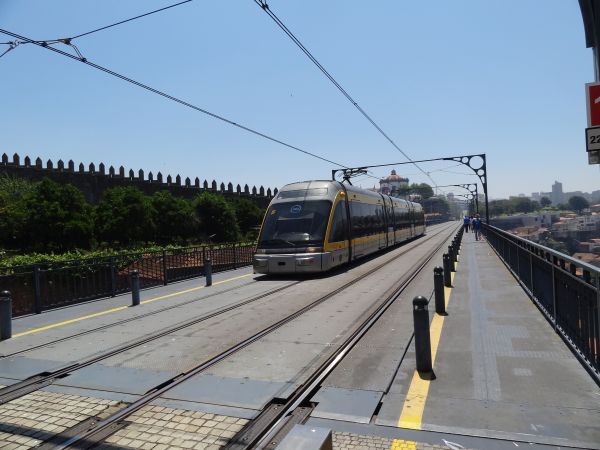
A closer look at the Metro do Porto Flexity Outlook no. 020 crossing the river Douro. Picture 23.6.2012 by Ilkka Siissalo.
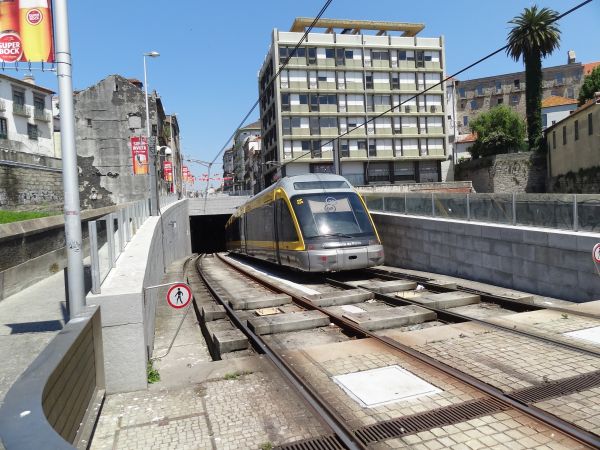
Here begins then the underground section under the old town of Porto. Picture 23.6.2012 by Ilkka Siissalo.
Funicular dos Guindais, Porto
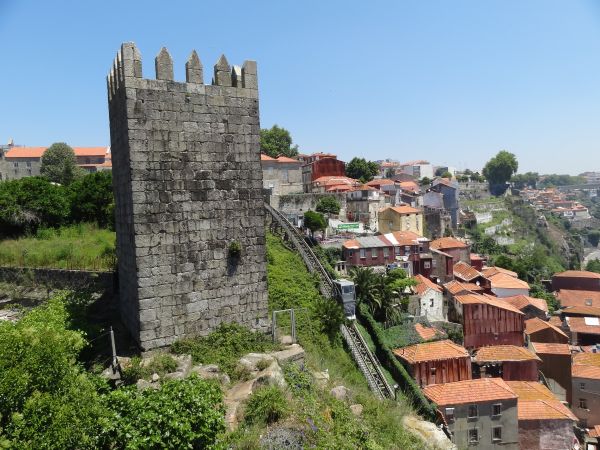
The Guindais funicular, Funicular dos Guindais, is a peculiar funicular train owned and operated by the Metro do Porto.
At the upper end the line begins at the metro station tunnel and it descends 61 metres in 281 metres of track running along
the old wall of Freiras. The line was inaugurated in 1891. Today it serves people who want to change from the boats on the river
Douro to the metro or vice versa. Picture of the Guindais funicular 23.6.2012 by Ilkka Siissalo.
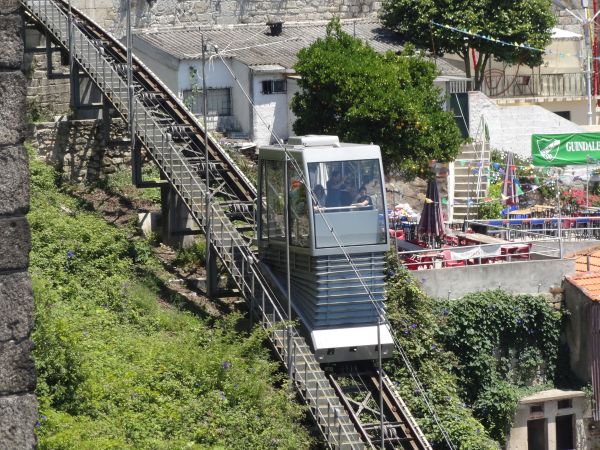
A closer look at the funicular wagon. Picture of the Guindais funicular 23.6.2012 by Ilkka Siissalo.
Porto tram museum
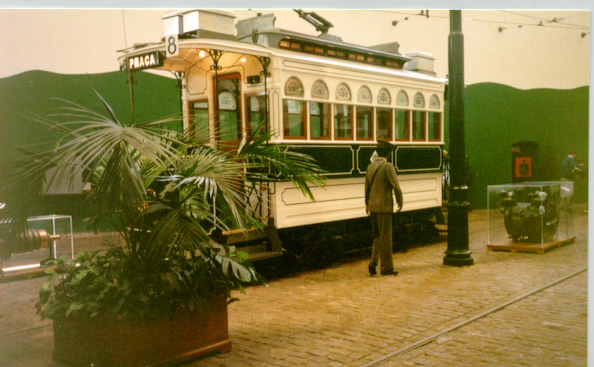
Porto tram number 8 from 1872 in Porto tram Museum.
This tram was originally pulled by mules and was only later electrified.
Photo by João Lima 29.10.97.
Uploaded Dec 6, 1997
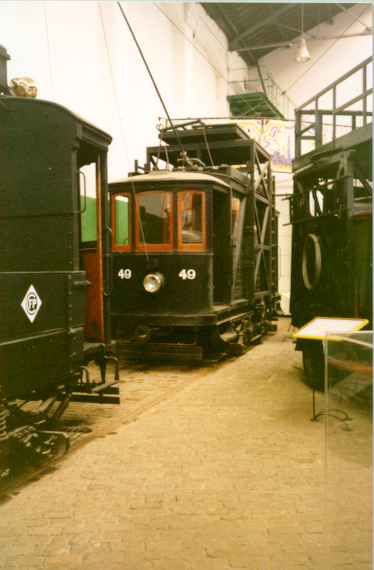
Porto service tram number 49 from 1915 in the Porto Tram Museum
Photo 29.10.97 by João Lima.
Uploaded Dec 6, 1997
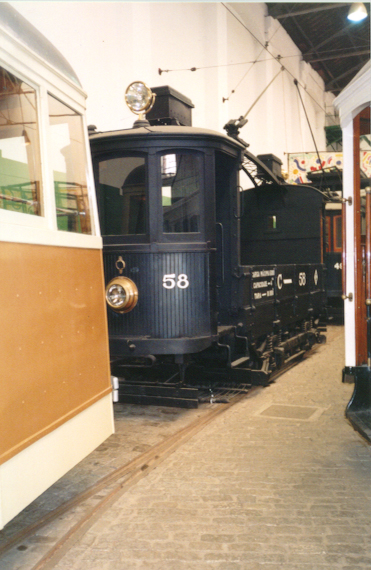
Porto service tram number 58 from 1915 in the Porto tram Museum
Photo 29.10.97 by João Lima.
Uploaded Dec 6, 1997

Porto trams number 100 and 163 from the years 1910 and 1905 respectively in the Porto tram Museum.
Photo 29.10.97 by João Lima.
Uploaded Dec 6, 1997
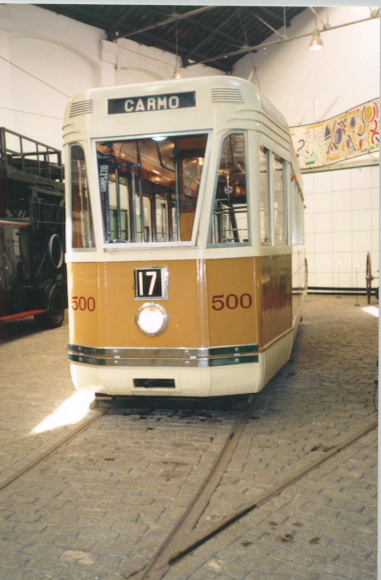
Porto tram number 500 from 1951 in the Porto tram Museum.
Photo 29.10.97 by João Lima.
Uploaded Dec 6, 1997
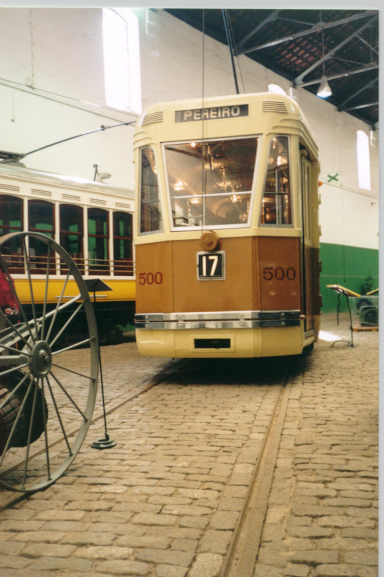
Another picture of the Porto tram number 500 from 1951 in the Porto tram Museum.
Photo 29.10.97 by João Lima.
Uploaded Dec 6, 1997
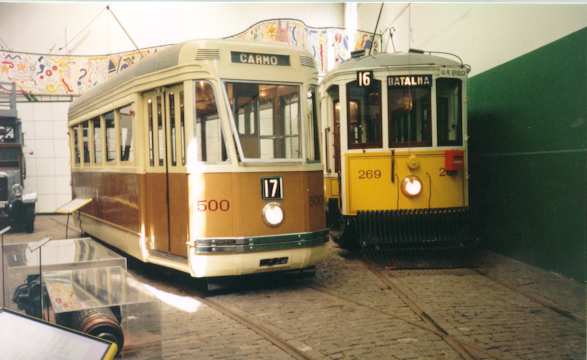
Porto trams number 500 and 269 in the Porto tram Museum.
Photo 29.10.97 by João Lima.
Uploaded Dec 6, 1997
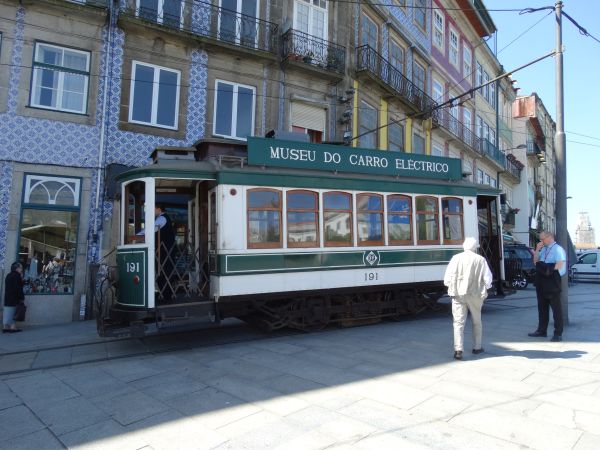
The Porto tram museum, Museu do Carro Eléctrico has a couple of old trams and tram coaches restored into their original shape and
paintings. This one, no. 191 is a model "Brill 28" from the year 1929, running here on the streets of Porto.
Picture 26.4.2018 by Ilkka Siissalo.

